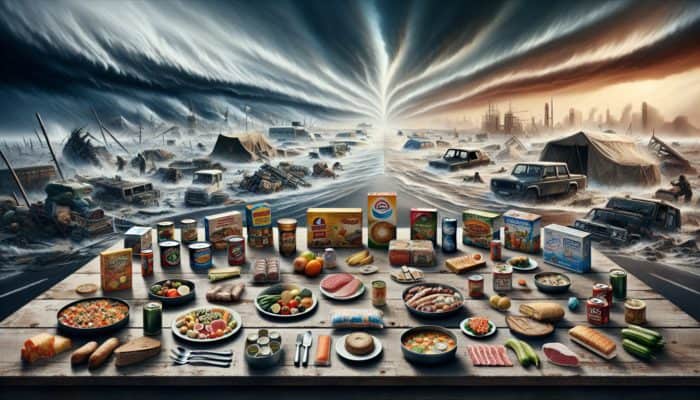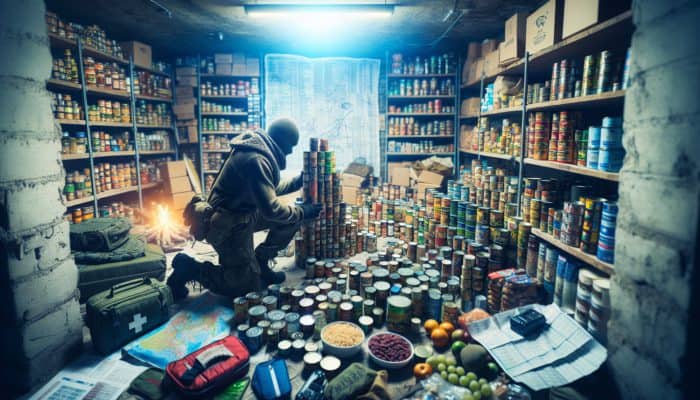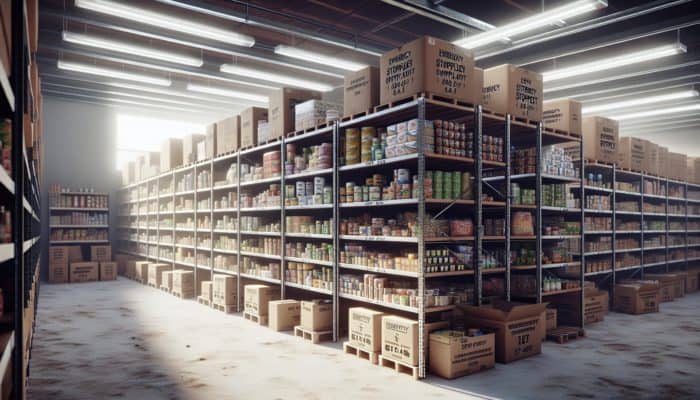Comprehensive Guide to SHTF Food Rations: Essential Preparation for Crisis Situations
Understanding the Importance of SHTF Food Rations: Key Insights You Must Know

Envision a scenario where access to regular food supplies is completely disrupted—this is precisely when SHTF food rations become indispensable. These meticulously curated emergency food supplies are specifically formulated to ensure sustenance during life-threatening circumstances, providing essential nutrients that are crucial for maintaining energy levels during extended periods without access to conventional food sources. The acronym SHTF, which stands for “Shit Hits the Fan,” encompasses situations such as natural disasters, societal breakdowns, or other emergencies. In such critical moments, having a well-thought-out stock of SHTF food rations is essential, empowering you and your loved ones to persevere through the most challenging obstacles.
In essence, SHTF food rations are designed for longevity and resilience. These food items are packaged to endure long-term storage, often remaining viable for years, or even decades, without spoiling. This category encompasses a multitude of options, including freeze-dried meals and nutrient-dense bars. The adaptability of these rations accommodates a broad spectrum of tastes and dietary preferences, thus being suitable for a diverse demographic. Being thoroughly prepared with the right selections can greatly enhance your chances of thriving in unforeseen circumstances.
The Crucial Role of SHTF Food Rations in Emergency Situations
The reality is stark: emergencies can occur without any warning. Maintaining a stock of shtf food rations readily accessible is not merely a precaution; it is an absolute imperative. During catastrophic events, food supply chains can disintegrate, leaving grocery store shelves completely empty. In these scenarios, the ability to depend on your well-stocked food reserves can be a matter of life and death. Ideally, SHTF food rations should bolster your health and energy, enabling you to concentrate on overcoming challenges rather than fretting about your next meal.
Furthermore, possessing a stockpile of SHTF food rations can yield significant psychological advantages. The assurance that you are equipped to confront whatever trials life may present fosters a sense of security and confidence. This mental fortitude is vital during emergencies when anxiety and uncertainty can easily overshadow one’s mindset. Additionally, it empowers you to assist others, be they family, friends, or neighbours, thereby enhancing community resilience during trying periods.
In a world where natural disasters, pandemics, and civil unrest are becoming increasingly commonplace, the necessity for SHTF food rations cannot be overstated. They serve not only as a means of survival but also as a fundamental resource that can mitigate the repercussions of various catastrophic occurrences.
Diverse Types of SHTF Food Rations for Every Emergency Scenario
Variety is paramount when it comes to shtf food rations. Different types of rations cater to varying needs, preferences, and emergency contexts. MREs, or Meals Ready-to-Eat, are perhaps the most recognised option. Utilised by military personnel, MREs are engineered for durability and practicality. They come fully prepared and necessitate minimal preparation, making them ideal for quick meals in high-pressure situations.
Freeze-dried meals present another outstanding choice. These meals preserve most of their nutrients since moisture is extracted, allowing for a prolonged shelf life while maintaining flavour integrity. Simply add water, and within moments, a delicious, nutritious meal is ready for consumption. Freeze-dried selections are particularly popular among outdoor enthusiasts and survivalists due to their lightweight and easily transportable nature.
Canned goods also form a crucial component of SHTF food rations. Although they may lack the gourmet appeal associated with freeze-dried meals, canned foods offer remarkable versatility, boasting a long shelf life and a broad array of choices, from vegetables to various protein sources. However, they often require can-opening tools and may be less convenient in specific scenarios.
Each category of shtf food rations possesses its unique advantages, and comprehending these distinctions can aid you in creating a well-rounded storage strategy. By taking into account factors such as nutritional value, ease of preparation, and shelf life, you can establish a stockpile that aligns with your needs and ensures you are ready for any eventuality.
Effective Strategies for Preparing Your SHTF Food Rations

Conducting a Thorough Evaluation of Your Food Requirements
Before embarking on the crucial task of stockpiling SHTF food rations, it is imperative to thoroughly assess your specific needs. Begin by determining the number of individuals who will depend on your food supplies and the estimated duration for which you anticipate needing them. This estimate can vary significantly depending on the circumstances; a fleeting natural disaster may necessitate fewer resources than an extended economic downturn. Having an accurate estimate guarantees that you are appropriately equipped.
Consider formulating a basic meal plan for the initial days or weeks of an emergency to pinpoint your caloric and nutritional requirements. Each individual’s needs will diverge based on factors such as age, activity levels, and health conditions. For instance, children and pregnant women typically require more calories and nutrients than the average adult. Allocate time to develop a tailored plan that accommodates your family’s specific composition.
In addition to determining the quantity of meals required, contemplate the types of food that will be most beneficial during a crisis. Review any dietary restrictions or preferences—such as vegetarian or gluten-free options—to ensure that everyone's needs are adequately met. This level of foresight not only safeguards health and safety but also elevates morale during challenging times, as having familiar and preferred foods can provide comfort in distressing situations.
Selecting the Most Suitable Rations for Your Emergency Stockpile
Choosing the right SHTF food rations extends beyond mere convenience; it is vital for preserving nutritional value and overall health during emergencies. Start by meticulously reviewing the nutritional content of prospective rations. Seek options that are abundant in proteins, carbohydrates, fats, vitamins, and minerals—after all, maintaining health is crucial when traditional food sources are unavailable.
The shelf life of the food is another essential consideration. Foods with prolonged shelf lives offer greater flexibility in planning and preparation, allowing for extended storage without the concern of spoilage. Aim for rations that provide a minimum of five years of shelf stability, or ideally longer, to ensure you are prepared for any situation.
Your personal dietary preferences should also influence your choices. If you have a favourite flavour or cuisine, incorporating it into your rations can enhance the overall experience. Don’t underestimate the psychological impact; meals that are familiar and enjoyable can significantly uplift spirits during stressful periods.
Moreover, consider the various food formats available. Whether it’s MREs, freeze-dried meals, or canned goods, choose combinations that deliver a diverse range of flavours and textures. This variety not only prevents palate fatigue but also ensures a more balanced diet, aiding in keeping spirits high when faced with challenges.
Implementing Smart Stockpiling Techniques for Your Emergency Supplies

A successful approach to stockpiling your SHTF food rations encompasses more than merely buying in bulk. Establishing a rotation system is essential to keep your supplies fresh and safe for consumption. Regularly consuming your stock and replenishing it with new supplies ensures that you always have rations that are within their freshness window.
Begin by organising your rations according to their expiration dates. Position older items at the forefront of your storage area and newer items at the back. This method ensures that you consume older food first, minimising waste and spoilage. It’s a straightforward yet profoundly effective technique for managing your supplies over time.
Store your SHTF food rations in a cool, dry location. Temperature fluctuations can hasten spoilage, so strive to identify a climate-controlled area when possible. Consider utilising airtight containers to combat moisture and pests, as these can jeopardise your food supply.
Additionally, maintain an inventory sheet that tracks what you have on hand and when it was purchased. This practice helps prevent overstocking and unanticipated shortages of critical supplies. Keeping a detailed record not only aids in rotation but also allows for more effective planning of future purchases.
Mastering Cooking Techniques for Emergency Scenarios
During a crisis, being adept at cooking using alternative methods is essential for maximising your SHTF food rations. Traditional cooking appliances may not be available, so it is prudent to familiarise yourself with versatile options such as camp stoves, portable grills, or even open fires. Each method presents its own challenges, but being knowledgeable about how to adapt can empower you to prepare nutritious meals under any circumstances.
Start by exploring camp stoves, which are lightweight and easy to transport. These stoves can operate on propane or butane and are invaluable for quick meal preparation. However, ensure you have sufficient fuel supplies and become acquainted with the stove prior to emergencies arising.
Open fires offer another viable option for cooking your SHTF food rations, but they require a bit more skill and caution. It’s critical to know how to build a safe fire and utilise it effectively for cooking. Using cast iron pots or grill grates can enable you to prepare a variety of meals over an open flame, ranging from soups to grilled dishes.
If possible, practice these cooking methods now, while you have the luxury of time. Cooking in simulated emergency conditions will not only build your confidence but also allow you to troubleshoot any issues that may arise. This preparation can mean the difference between enjoying a satisfying meal and enduring a frustrating experience during stressful times.
Nutritional Foundations for SHTF Food Rations
Identifying Essential Nutrients for Optimal Health During Emergencies
During a crisis, the significance of nutrition cannot be overstated. Your shtf food rations should comprise a well-balanced assortment of essential nutrients to support bodily functions and mental clarity. Proteins, carbohydrates, and fats all play vital roles in sustaining energy levels and overall health.
Proteins are crucial for muscle repair, immune function, and cellular health. When selecting shtf food rations, prioritise sources such as canned meats, beans, and protein bars. Carbohydrates serve as the body's primary energy source; opt for whole grains such as rice and pasta—these provide sustained energy along with necessary fibre to facilitate digestion.
Fats hold equal importance. Healthy fats assist in the absorption of vitamins and offer concentrated energy. Consider incorporating options like nut butters or canned fish in oil into your emergency food stockpile. Furthermore, do not overlook the necessity of vitamins and minerals; these are crucial for preventing deficiencies during extended periods without access to fresh food. Including fortified foods or multi-vitamins in your rations can help ensure that you’re adequately nutritionally supported.
Ultimately, the objective is to adopt a balanced strategy that prioritises overall health while addressing energy needs during a crisis. Taking the time to select a diverse array of nutrients in your SHTF food rations will yield significant benefits when it comes time to rely on your preparations.
Assessing Caloric Needs for Crisis Scenarios
Estimating the appropriate caloric intake for each individual during a crisis is vital for sustaining energy levels. Average caloric requirements can vary significantly based on age, sex, and activity levels, making it critical to tailor your SHTF food rations accordingly.
A rough estimate for adult men is approximately 2,500 calories per day, while women generally require around 2,000 calories per day. However, during physically demanding activities—whether it involves defending your home or foraging for resources—these figures may increase. It’s wise to plan for a higher caloric intake when assessing your food needs.
As you prepare your rations, contemplate incorporating calorie-dense foods like nuts, dried fruits, and energy bars. These options provide quick energy and can be indispensable when resources are limited. Additionally, keep track of the caloric content of all foods you stockpile to ensure you meet the required daily intake.
An effective plan will comprise meals that are easily portioned, allowing you to adjust servings according to daily activities and requirements. Being mindful of caloric consumption can help prevent fatigue and maintain high morale, which is crucial during a crisis.
Addressing Special Dietary Requirements in Your Emergency Rations
When preparing SHTF food rations, it is essential to take into account any special dietary needs within your group. This could encompass allergies, intolerances, or specific dietary preferences such as vegetarianism or veganism. Neglecting to address these issues can lead to health concerns or unnecessary stress during already challenging times.
Begin by evaluating the dietary restrictions of everyone who will rely on these rations. Common allergens include nuts, dairy, and gluten, so it is vital to read labels meticulously and select alternatives that cater to these needs. For those adhering to vegetarian or vegan diets, ensure you have a sufficient supply of plant-based proteins, such as legumes, tofu, or meat substitutes available in various forms.
Planning meals that accommodate everyone’s dietary requirements can also aid in maintaining morale and fostering a sense of community. When individuals can enjoy meals without concerns about allergies or preferences, it creates a more comfortable atmosphere, even in the most dire of circumstances.
Moreover, it is wise to include a variety of options that can cater to multiple preferences. Stocking up on gluten-free grains, nut-free snacks, and dairy alternatives will ensure that your SHTF food rations are inclusive, allowing everyone to feel secure about their food choices.
Best Practices for Storing and Preserving Your Emergency Food Provisions
Understanding the most effective methods for storing and preserving your SHTF food rations is vital for maintaining their nutritional value and extending their shelf life. Start by selecting appropriate packaging strategies to shield your food from moisture, pests, and environmental changes.
Airtight containers are essential for bulk items like grains and legumes, while vacuum-sealed bags can keep smaller portions fresh for longer periods. Mylar bags are another excellent option, as they can block light and oxygen, two factors that contribute to food spoilage. When utilising these storage methods, be sure to include oxygen absorbers to further enhance the preservation process.
Temperature plays a significant role in maintaining food quality. Ideally, your rations should be stored in a cool, dark location, such as a basement or an interior pantry away from direct sunlight. Avoid storing food in areas that experience extreme temperature variations, as this can lead to spoilage. If possible, regularly monitor temperatures to ensure they remain stable and consistent.
Another critical aspect of food preservation involves understanding the specific storage requirements for different types of rations. For instance, freeze-dried meals should be kept in a dry environment, while canned goods can tolerate a bit more fluctuation. Familiarise yourself with the nuances of each food type in your stockpile to ensure optimal longevity.
Strategies for Effective Storage and Preservation of Food Rations
Creating Optimal Storage Conditions for Your Rations
The conditions under which you store your SHTF food rations significantly influence their longevity and safety. Start by designating a storage area that is cool, dry, and dark, as this environment minimises the risk of spoilage and contamination. Ideally, maintain temperatures below 70°F (21°C) and keep humidity levels low, as excessive moisture can lead to mould, bacteria, and pest infestations.
Avoid areas that experience significant temperature fluctuations, such as attics or garages, as these can create an unstable environment for food storage. Consider investing in a thermometer and hygrometer to monitor your storage conditions and make adjustments as necessary.
Utilising shelving for organisation allows for improved air circulation and facilitates stock rotation as expiration dates approach. Ensure that the shelves are sturdy enough to support the weight of canned goods and bulk items, thus keeping your food secure and accessible.
Additionally, store your SHTF food rations away from direct sunlight. UV rays can degrade packaging and diminish food quality over time. If possible, use opaque containers or store items in closets or pantry spaces that limit light exposure. This simple practice can significantly extend the shelf life of your emergency food supplies.
Selecting Suitable Packaging and Containers for Your Food Supplies
The packaging you choose for your shtf food rations is crucial for ensuring food quality and safety. Airtight containers are vital for bulk items such as rice, pasta, and legumes, as they prevent moisture and pests from infiltrating. Glass jars, metal cans, or robust plastic bins can all serve as effective storage solutions.
Mylar bags, often utilised for long-term food storage, are another excellent choice. These bags can be sealed with an iron or heat sealer and are highly effective at blocking light and oxygen, two critical factors that contribute to food degradation. Including oxygen absorbers in Mylar bags can further prolong your food’s shelf life by eliminating unwanted oxygen that may lead to spoilage.
Clearly label everything, including contents and expiration dates. This practice not only aids in organisation but also helps you keep track of what needs to be rotated or consumed first. Consider using colour coding for labels for quick visual reference, making it easier to manage your SHTF food rations inventory effectively.
Finally, ensure that all containers are clean and dry before filling them with food. Any residual moisture can compromise the integrity of your rations, leading to spoilage or contamination. Properly packaging and labelling your supplies is a vital step that can significantly impact your preparedness for an emergency.
Implementing Shelf Life Management Techniques for Your Rations
Managing the shelf life of your SHTF food rations is essential for ensuring they remain safe and consumable when you need them most. Regularly check the expiration dates on your stock and rotate items to guarantee that older products are consumed first. This practice will minimise waste and keep your food supply in peak condition.
Create a straightforward inventory system that tracks what you have and when it was purchased. This system can be as simple as an Excel spreadsheet or even handwritten notes. Keeping accurate records helps you stay organised and aware of which items need to be used or replaced.
Consider implementing a colour-coded system to indicate the freshness of your supplies. For example, mark items nearing their expiration date with a bright sticker or label, signalling that these should be prioritised in your meal planning.
Remember that not all foods have the same shelf life. Familiarise yourself with the items in your stockpile, noting which foods deteriorate more quickly than others. By closely monitoring your inventory and proactively replacing items, you’ll ensure that your SHTF food rations remain a reliable resource during emergencies.
Cooking and Preparation Techniques for SHTF Food Rations
Exploring Cooking Methods Without Electricity
When the power goes out, knowing how to cook without electricity becomes vital for utilising your SHTF food rations effectively. Start by familiarising yourself with alternative cooking methods, such as portable camping stoves, solar ovens, or open fires, each presenting unique challenges and opportunities.
Portable propane or butane stoves are excellent for rapid meal preparation. They are lightweight and user-friendly, but they require fuel, so be sure to stock up on extra canisters. Before an emergency occurs, practise using your camping stove to become familiar with its controls and functions, saving you time and potential mishaps when you need it most.
Open fires can be more complex but provide an effective cooking method. Learn how to build a safe fire and use cast iron pots or grill grates for cooking. Mastering the art of cooking over an open flame can yield delicious meals, though it requires patience and practice.
Additionally, consider solar ovens as a sustainable option for cooking. While they take longer to cook food, they do not require fuel; instead, they harness the sun's energy. Invest in a high-quality solar oven and experiment with various meals to understand how best to utilise it during a crisis.
Understanding Water Requirements for Food Preparation
Water is an essential component when it comes to preparing SHTF food rations. Many freeze-dried meals and other rations necessitate water for rehydration or cooking, making it critical to have an adequate supply on hand. Ideally, store at least one gallon of water per person per day for consumption and cooking purposes.
Consider water purification methods to ensure that you can access clean water from natural sources should your regular supply become compromised. Water filters, purification tablets, or boiling can all serve as effective strategies for making water safe to drink.
As you prepare your rations, be mindful of the amount of water required for each meal. Keeping this information accessible will enable you to plan effectively and ensure that you don’t run short during critical moments.
Finally, explore alternative water sources in your vicinity. Rainwater collection systems or nearby rivers can serve as excellent backups. Understanding your options will enhance your resilience during a crisis, enabling you to adapt as necessary without compromising your food preparation.
Embracing Minimalist Cooking Techniques for Resource Efficiency
In a survival scenario, adopting minimalist cooking techniques can help conserve resources and simplify meal preparation using your SHTF food rations. Focus on methods that require less fuel or time, allowing you to extend your resources while still receiving adequate nutrition.
One effective strategy is utilising one-pot meals. These dishes require minimal cooking equipment and can be prepared using fewer ingredients, making them ideal for emergencies. Think of soups, stews, or casseroles that combine various food items into a single dish. This approach saves energy and reduces cleanup, making it a practical choice during crisis periods.
Another technique is to utilise no-cook meals, particularly those that require only minimal preparation or assembly. Options like protein bars, canned goods, or ready-to-eat meals can provide quick, filling alternatives without the need for extensive cooking.
Experiment with these techniques now so you can master them when the need arises. Practising cooking from your SHTF food rations using minimalist methods will ensure you feel comfortable and confident when it matters most. This preparation will not only save you time and energy but can also help you create satisfying meals while navigating challenging circumstances.
Innovative Food Storage Solutions for Long-Term Preservation
Maintaining the freshness and nutritional value of your SHTF food rations heavily relies on effective food storage solutions. Aim to employ various methods that maximise shelf life and protect against spoilage.
Vacuum sealing is one of the most effective methods for preserving food. By removing air from bags before sealing, you can significantly extend the shelf life of many food items. This technique is particularly beneficial for bulk items, such as grains and meats, which are more vulnerable to spoilage.
Mylar bags, as previously mentioned, are another fantastic option for long-term storage. These bags provide a barrier against light and oxygen, enhancing the preservation process. Pair Mylar bags with oxygen absorbers to ensure that your food remains safe and nutrient-dense.
Additionally, consider constructing a small root cellar or utilising temperature-controlled storage solutions to maintain optimal conditions for your rations. By storing your supplies in environments that regulate temperature and humidity, you can protect them from spoilage and guarantee they are ready for consumption.
Finally, regularly check the condition of your stored food. Monitoring for any signs of spoilage or pest infestation will help you catch potential issues early, allowing you to implement corrective measures before they escalate.
Assembling a Comprehensive Emergency Cooking Kit
Creating an emergency cooking kit is a wise strategy for effectively preparing your SHTF food rations. This kit should include essential tools and utensils specifically designed for cooking without electricity.
Start with a portable camp stove and the required fuel, along with lightweight cookware and utensils. Don’t forget items such as a cutting board and a sharp knife, which are essential for meal preparation. A multi-tool can also be a valuable addition, offering versatility in a compact form.
Consider including items such as a firestarter, matches, or lighters to facilitate cooking over an open flame. Additionally, pack some non-perishable food items that require minimal or no cooking for quick snacks or meals.
Ensure that your cooking kit is easily accessible and that everyone in your household knows its location. Regularly review and update the kit to ensure that all components remain in good condition and that you have sufficient fuel and supplies for prolonged use.
In a crisis, having your emergency cooking kit ready to go will enable you to prepare nutritious meals swiftly and efficiently, minimising stress and allowing you to focus on more immediate survival concerns.
Effective Rationing and Consumption Techniques for Emergencies
Strategising Daily Ration Planning for Crisis Management
Effective daily ration planning is crucial for managing your SHTF food rations during a crisis. Developing a structured plan will help ensure that you maintain a consistent supply of nutrients and avoid depleting essential food items too quickly.
Begin by determining how many meals you’ll need to prepare each day. Consider the number of individuals in your group and their caloric needs, as discussed earlier. This information will assist you in creating a meal plan that meets everyone's requirements without exhausting your supplies prematurely.
Once you have a meal plan established, break down the daily rations into manageable portions. Think about the types of meals you will prepare and the ingredients required, ensuring to include a variety of food groups. This diversity will help sustain morale and prevent palate fatigue during an already demanding period.
Make a concerted effort to monitor your daily consumption. Keeping track of what is eaten each day will enable you to adjust your rations as needed, ensuring that you always have enough food to sustain your group.
Finally, clearly communicate the plan with everyone involved. When everyone understands the rationing system, it fosters cooperation and helps maintain a sense of community during uncertain times, ultimately simplifying the effective management of your SHTF food rations.
Frequently Asked Questions About SHTF Food Rations
What are the most effective types of SHTF food rations to consider?
The most effective types include MREs, freeze-dried meals, and canned goods, each offering distinct advantages such as extended shelf life, ease of preparation, and variety.
How much food should I stockpile for potential SHTF scenarios?
Calculate your needs based on the number of people and the anticipated duration of the crisis. Aiming for at least a two-week supply is a prudent starting point.
What is the typical shelf life of SHTF food rations?
Depending on the type, many SHTF food rations can last several years or even decades if stored properly.
Are SHTF food rations suitable for children?
Yes, but it is crucial to consider their specific caloric and nutritional needs. Including kid-friendly options can help sustain their interest.
What is the best way to store my SHTF food rations?
Store them in a cool, dry, and dark space using airtight containers or Mylar bags to prolong shelf life and prevent spoilage.
How often should I check my food supplies for freshness?
Regularly check your supplies at least every six months, rotating items and ensuring nothing has passed its expiration date.
Can I incorporate my SHTF food rations into everyday meals?
Absolutely! Integrating some of your stock into regular meals can help keep your food supply fresh and your culinary skills sharp.
What cooking methods should I learn for SHTF scenarios?
Focus on alternative methods such as camp stoves, open fires, and solar cookers to prepare meals in the absence of electricity.
How should I address special dietary needs within my rations?
Review and select ration options that accommodate your dietary requirements, ensuring you have suitable food for any restrictions.
How can I maintain morale while relying on my SHTF food rations?
Plan meals that feature comfort foods and familiar flavours. Variety and creativity in meal preparation can significantly boost spirits during tough times.
Discover more on our X platform!
The post SHTF Food Rations: Essential Survival Guide appeared first on Survival Bite.
The Article SHTF Food Rations: Your Essential Survival Guide Was Found On https://limitsofstrategy.com

